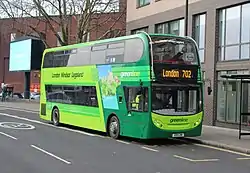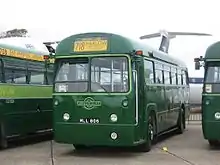Green Line Coaches
Green Line is a commuter coach brand in the Home counties of England. It is owned by Arriva.
 Reading Buses Alexander Dennis Enviro400 on Hammersmith Bridge Road in January 2018 | |
| Parent | Arriva |
|---|---|
| Founded | 9 July 1930 |
| Service area | Greater London, Home counties |
| Service type | Coach services |
| Hubs | Green Line Coach Station |
| Operator | Arriva Shires & Essex Reading Buses |
| Website | www.greenline.co.uk |
Green Line had its origin in the network of coach services established by the London General Omnibus Company (LGOC) in the 1920s and 1930s. After World War II, the network was part of London Transport Executive/London Transport Board, and from 1970 to 1986 was operated by London Country Bus Services.
History

%252C_Showbus_2012_rally.jpg.webp)


.jpg.webp)

Early history
Green Line Coaches Limited was formed on 9 July 1930 by the LGOC, which from 1927 had built up a network of coach services from London to towns up to 30 miles away, comprising 60 vehicles on eight routes. These services were largely started in response to the emergence of numerous small independent operators, often running single routes. As well as express services operated by LGOC, some were run by subsidiary companies such as East Surrey Traction & Autocar Services and some on LGOC's behalf by the National Omnibus & Transport Company. The Green Line livery and fleetname was rolled out across the existing express services.[1][2][3]
New services quickly followed, with the number of routes increasing to 27 by October 1931 and the number of coaches to 275. Green Line also began to acquire some of its independent competitors. The laying over of coaches in central London began to create congestion, so, to relieve this, some routes were linked to form cross-London services, and a short-lived coach station was opened in Poland Street, Soho at the end of 1930.[1][2]
On 1 July 1933, Green Line passed to the new London Passenger Transport Board and competing services within the London Passenger Transport Area were absorbed into the network. Various vehicles of numerous different types were inherited, and much effort was made in replacing these with a standardised fleet of vehicles from late 1936. Poland Street coach station was closed, and almost all routes were linked to run across London.[1][4]
Post-war era
Services were suspended during World War II, resuming in February 1946.[5] More services were added, and the routes were given numbers in the 700 series. Ridership increased to a peak of 36 million passenger journeys a year between 1957 and 1960. In 1962, AEC Routemaster double-deck coaches were introduced on some routes, notably route 721 which ran every 12 minutes at peak times, and route 704 conveying tourists to Windsor and Royal Tunbridge Wells.[6][7][8][9] Orbital coach routes commenced:[10]
- 724 from High Wycombe around the north of London to Romford
- 725 from Windsor around the south of London to Gravesend
- 727 from Crawley around the west of London to Luton
In 1970, London Transport became the responsibility of the Greater London Council, so control of Green Line was passed from London Transport to London Country Bus Services, part of the state-owned National Bus Company. Patronage was declining, partly as a result of increasing car use and quicker parallel rail services, and the last cross-London routes ceased in 1979.[1]
The Transport Act 1980 deregulated coach services, and Green Line expanded services beyond its traditional area, to Cambridge (route 797), Oxford (routes 290 and 790, in conjunction with the Oxford Bus Company), Northampton and Brighton. New airport services also commenced:[3]
- 747 Heathrow Airport to Gatwick Airport
- 757 Green Line Coach Station to Luton Airport
- 767 Green Line Coach Station to Heathrow Airport
- 777 Green Line Coach Station to Gatwick Airport
By this time, the orbital services 724 and 726 (a variant of the 725) had been revised to serve Heathrow.[10] Green Line also became a National Express operator.
Privatisation
In 1986, London Country was divided into four operating companies to prepare for privatisation.[11] They were sold separately, and ownership of the Green Line network became fragmented, with only a few routes surviving. The airport services passed to Jetlink and are now operated by National Express.
The orbital route 726 was taken over by London Regional Transport in a reduced form and in April 2005 was renumbered London Buses route X26.[12] By the mid-1990s, Arriva had become the owner of most of the London Country successor companies and became the owner of the Green Line brand. It licensed the brand to other operators: First Berkshire & The Thames Valley (700, 701 and 702), New Enterprise Coaches (routes 781 and 784 from 2005 to 2009) and Stephensons of Essex (routes X1 and X10 from 2002 until 2008).
Following closure of its Bracknell depot in 2015, First Berkshire services were revised and routes 700 and 701 were discontinued. Reading Buses took over operation of route 702 on 24 December 2017.[13] On 8 May 2018, the 702 was withdrawn between Legoland Windsor and Bracknell. On the same day, route 703 was introduced under the Green Line brand, running between Heathrow Terminal 5 and Bracknell, replacing the withdrawn section.[14][15]
In April 2020, Arriva Shires & Essex was scheduled to commence operating a new Green Line route 720 from Stansted Airport to Liverpool Street, but was delayed due to the COVID-19 pandemic.[16]
Current services
- 702: Legoland, Windsor and Slough to Green Line Coach Station (extended from Legoland to Bracknell and Reading at peak times)[17]
- 703: Bracknell, Legoland, Windsor and Slough to Heathrow Terminal 5[18]
- 724: Heathrow Airport to Harlow via St Albans[19]
- 748/758/759: Hemel Hempstead to Green Line Coach Station[20]
- 755/757: Luton and Luton Airport to Green Line Coach Station[21]
References
- History Archived 14 November 2007 at the Wayback Machine Green Line Coach Services
- Jones, DWK; Davis, BJ (1980). Green Line 1930-1980. Reigate: London Country Bus Services. pp. 4–17. ISBN 978-0-905009-02-5.
- Companion to Road Passenger Transport History. Walsall: Roads & Road Transport History Association. 2013. pp. 241/242. ISBN 9780955287633.
- Jones, DWK; Davis, BJ (1980). Green Line 1930-1980. Reigate: London Country Bus Services. pp. 22–35. ISBN 978-0-905009-02-5.
- Green Line Coaches Railway Gazette 8 February 1946 page 158
- The Coach RMs Archived 1 February 2014 at the Wayback Machine Country Bus
- The Long Coaches Archived 1 February 2014 at the Wayback Machine Country Bus
- Routemaster Double-deck Coaches for Green Line Routes Archived 2 February 2016 at the Wayback Machine Commercial Motor 29 June 1962
- Larger Routemaster Coaches for Green Line Archived 4 March 2016 at the Wayback Machine Commercial Motor 30 October 1964
- Green Line Coach Routes 724-799 Archived 16 September 2008 at the Wayback Machine E Plates
- Out on its own Archived 14 July 2014 at the Wayback Machine Commercial Motor 6 December 1986 page 54
- "Slow death of a Green Line orbital" Buses |issue 603 June 2005 page 19
- Reading Buses to take over Green Line 702 with special running day Coach & Bus Week issue 1318 21 November 2017 page 19
- Exciting changes to Green Line Reading Buses
- Reading Buses launches direct Bracknell to Heathrow link Coach & Bus Week issue 1338 17 April 2018 page 11
- Green Line 720 returns to Stansted after 43 years Buses issue 782 May 2020 page 22
- 702 Reading Buses
- 703 Reading Buses
- Green Line Route 724 Arriva
- Route 758 timetable Archived 18 July 2016 at the Wayback Machine Greenline
- Routes 755 & 757 timetable Archived 10 July 2016 at the Wayback Machine Greenline
External links
| Wikimedia Commons has media related to Green Line (London coach network). |